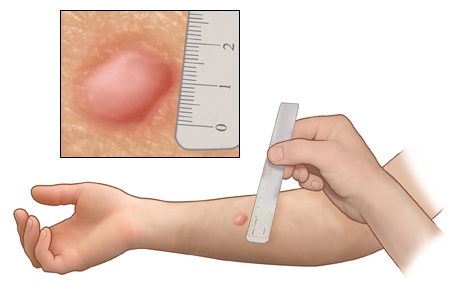Tuberculosis (TB) is caused by a mycobacterium tuberculosis, a pathogenic bacteria that can be spread through air. The lungs is where the infection commonly affects, and the bacteria can remain dormant in your body for many years before producing any symptoms. If your immune system becomes weakened, TB can become active and symptoms will occur, like coughing, fever, loss of weight and sweating throughout the night.
TB is a serious infection, so if you believe you may have been exposed to the infection, then you should go to your doctor and ask for a TB test.
What's a Positive TB Test Like?
To test for TB, a health care provider will inject a slight amount of PPD (purified protein derivative) into your forearm, and then waita couple days to see if there is any reaction, slight or adverse. According to the CDCs (center for Disease Control and Prevention):
- A reaction of 15mm or more is considered a positive result in all people from all backgrounds.
- For children, some immigrants, those who use drugs and others who fit into additional risk assessment categories, a 10mm reaction is positive.
- If you are deemed to be within in the high risk category for this infection, a reaction of 5mm is positive.
 If your health care provider determines the test to be positive, they will often advise that you receive a chest X-ray to check the activeness and severity of the infection and to determine whether the TB is still dormant inside your body.
If your health care provider determines the test to be positive, they will often advise that you receive a chest X-ray to check the activeness and severity of the infection and to determine whether the TB is still dormant inside your body.
If the infection is still dormant, then your goal of treatment is to prevent the dormant infection becoming active. If it is active, you will receive treatment to help get rid of the disease.
How to Understand the Results of a TB Test
If you’ve made it this far and you're still thinking,"What does a positive TB test look like?" then this will be clear to you soon.
If you have had the test and the patch of skin that the PPD was injected into is only marginally swollen or not swollen at all, then your test results would be negative in most cases.
1. As mentioned, a slight reaction (after 48-72 hours) of 5mm at the area of the PPD injection is considered positive in high risk patience, which includes those who are positive with the HIV virus, those who have been in close proximity with a person who has pulmonary TB, those who have received transplanted organs, and those with weakened immune systems.
2. A test result of around 10mm is positive for:
- Those with diabetes, kidney failure, or similar conditions
- Drug users
- Infants that have been exposed to high risk adults or health-care workers
- Those who reside within certain environments determined to be of high risk
- Immigrants who have left a country with a high rate of TB infections
3. For all of those who fit into none of the risk assessment categories mentioned, a 15mm reaction is considered positive.
The PPD test for TB is not without error. It is conceivable for the results to return false-positive or false-negative, because certain vaccines, steroids and medical treatments can affect the results of a PPD.
How to Prepare for a TB Test
There is little preparation required before a TB test. The essential thing is to discuss with your doctor about your previous or current medical conditions or treatments, if you are taking steroids, or if you have had a positive PPD test. These can all affect your results, making it vital to tell your doctor before you get tested for TB.
How Is a TB Test Performed?
The test for TB is performed by your doctor. It uses a needle to inject PPD into your forearms. This injection occurs under the top layer of your skin, and will cause a small bump in the injected area which usually disappears after a few hours as the PPD is absorbed.
After 48 to 72 hours you have to return to your doctor's, so they can check to see if you have had any reaction to the injection. This process is usually a painless one, except for the small sting you may feel upon the entry of the needle.
Symptoms of TB
Now that you have known "What does a positive TB test look like?", Let's find out what the symptoms of TB are. As mentioned above, those with inactive (or latent) TB will have no symptoms. Active (or pulmonary) TB does have symptoms, which include:
- Continuous coughing
- Coughing up blood
- Fatigue
- Constant fever
- Chest pain
- Excessive sweating
These symptoms do not always point to TB and they can be signs of other infections and illnesses. If you are experiencing any of the symptoms mentioned, getting tested by a health care provider will help you determine the cause.
